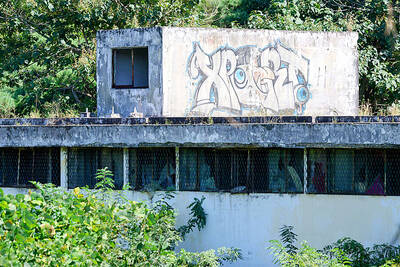A Chinese court yesterday sentenced nine fentanyl traffickers in a case that was a culmination of a rare collaboration between Chinese and US law enforcement to crack down on global networks that manufacture and distribute lethal synthetic opioids.
Liu Yong (劉勇) was sentenced to death with a two-year reprieve, while Jiang Juhua (蔣菊華) and Wang Fengxi (王風璽) were sentenced to life in prison.
Six other members of the operation got lesser sentences, ranging from six months to 10 years.
Working off a 2017 tip-off from the US Department of Homeland Security about an online drug vendor who went by the name Diana, Chinese police busted a drug ring in Xingtai that shipped synthetic drugs to the US and other nations from a gritty clandestine laboratory.
They arrested more than 20 suspects and seized 11.9kg of fentanyl, as well as 19.1kg of other drugs.
In its form, the enterprise resembled a small business, with a perky sales force that spoke passable English, online marketing, contract manufacturing and a sophisticated export operation, US and Chinese law enforcement said.
However, the business had grave implications. Police photographs of the seizure show a dingy, chaotic scene, with open containers of unidentified chemicals, and Chinese police officers in rubber gloves and breathing masks.
Liu and Jiang were accused of manufacturing and trafficking illicit drugs. The others were accused of trafficking.
Death sentences are almost always commuted to life in prison after the reprieve.
Chinese officials said the Xingtai case was one of three fentanyl trafficking networks they are pursuing based on US intelligence, but declined to discuss the details of the other cases, which are ongoing.
Homeland Department attache to China Austin Moore said the Xingtai case was “an important step,” showing that Chinese and US investigators have the capacity to collaborate across international borders.
Scrambling to contain surging overdose deaths, Washington has blamed Beijing for failing to curb the supply of synthetic drugs that US officials say come mainly from China.
US President Donald Trump in August criticized Chinese President Xi Jinping (習近平) for failing to do more to combat illicit opioid distribution in China’s vast, freewheeling chemicals industry.
US officials have reportedly moved to link Beijing’s efforts on fentanyl to trade talks.
China National Narcotics Control Commission Deputy Director Yu Haibin yesterday called allegations that Chinese supply is at the root of the opioid problem in the US “irresponsible and inconsistent with the actual facts.”
“Drug crime is the public enemy of all humankind,” he said. “It’s about the life of human beings. It should not be related with the trade war or other political reasons.”
Chinese officials have been at pains to emphasize the efforts they have made to expand drug controls and crack down on illicit suppliers, even though synthetic opioid abuse is not perceived to be a significant problem in China, but prosecuting cases against a new, rising class of synthetic drug kingpins has remained a challenge.
Profit-seeking chemists have adroitly exploited regulatory loopholes by making small changes to the chemical structure of banned substances to create so-called analogues that are technically legal.
US officials have been hopeful that China’s move earlier this year to outlaw unsanctioned distribution of all fentanyl-like drugs as a class would help constrain supply and make it easier to prosecute Chinese dealers.
According to the US Centers for Disease Control and Prevention, more than 500,000 Americans died of drug overdoses in the decade ending in 2017 — increasingly from synthetic opioids such as the ones sold by the Xingtai network.

LANDMARK CASE: ‘Every night we were dragged to US soldiers and sexually abused. Every week we were forced to undergo venereal disease tests,’ a victim said More than 100 South Korean women who were forced to work as prostitutes for US soldiers stationed in the country have filed a landmark lawsuit accusing Washington of abuse, their lawyers said yesterday. Historians and activists say tens of thousands of South Korean women worked for state-sanctioned brothels from the 1950s to 1980s, serving US troops stationed in country to protect the South from North Korea. In 2022, South Korea’s top court ruled that the government had illegally “established, managed and operated” such brothels for the US military, ordering it to pay about 120 plaintiffs compensation. Last week, 117 victims

China on Monday announced its first ever sanctions against an individual Japanese lawmaker, targeting China-born Hei Seki for “spreading fallacies” on issues such as Taiwan, Hong Kong and disputed islands, prompting a protest from Tokyo. Beijing has an ongoing spat with Tokyo over islands in the East China Sea claimed by both countries, and considers foreign criticism on sensitive political topics to be acts of interference. Seki, a naturalised Japanese citizen, “spread false information, colluded with Japanese anti-China forces, and wantonly attacked and smeared China”, foreign ministry spokesman Lin Jian told reporters on Monday. “For his own selfish interests, (Seki)

Argentine President Javier Milei on Sunday vowed to “accelerate” his libertarian reforms after a crushing defeat in Buenos Aires provincial elections. The 54-year-old economist has slashed public spending, dismissed tens of thousands of public employees and led a major deregulation drive since taking office in December 2023. He acknowledged his party’s “clear defeat” by the center-left Peronist movement in the elections to the legislature of Buenos Aires province, the country’s economic powerhouse. A deflated-sounding Milei admitted to unspecified “mistakes” which he vowed to “correct,” but said he would not be swayed “one millimeter” from his reform agenda. “We will deepen and accelerate it,” he

Japan yesterday heralded the coming-of-age of Japanese Prince Hisahito with an elaborate ceremony at the Imperial Palace, where a succession crisis is brewing. The nephew of Japanese Emperor Naruhito, Hisahito received a black silk-and-lacquer crown at the ceremony, which marks the beginning of his royal adult life. “Thank you very much for bestowing the crown today at the coming-of-age ceremony,” Hisahito said. “I will fulfill my duties, being aware of my responsibilities as an adult member of the imperial family.” Although the emperor has a daughter — Princess Aiko — the 23-year-old has been sidelined by the royal family’s male-only